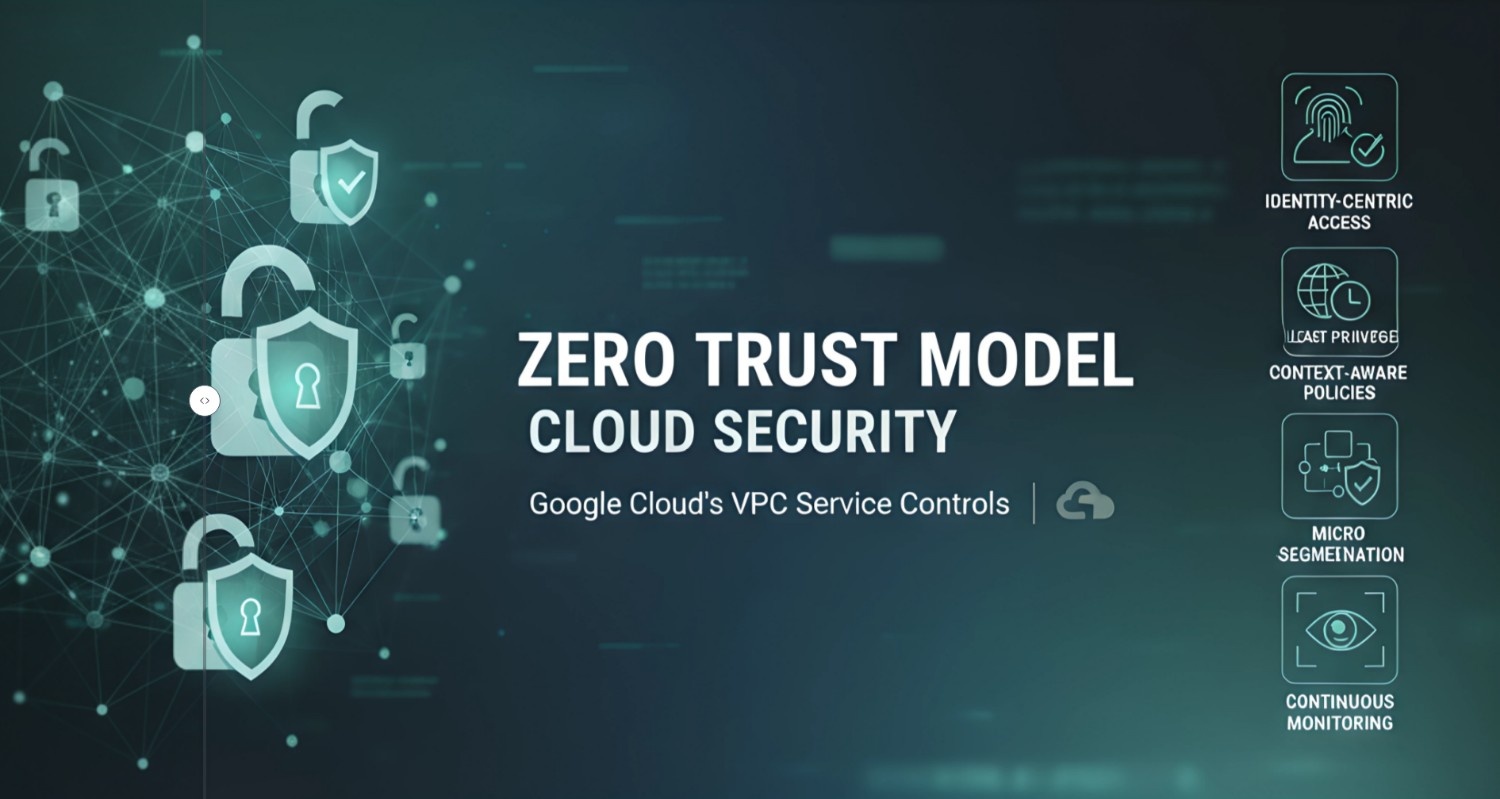As organizations continue their digital transformation journeys, securing cloud environments has become more critical than ever. Traditional perimeter-based security is no longer sufficient in a world where workloads are distributed across hybrid and multi-cloud environments.
Enter the Zero Trust model — a modern approach to cloud security that assumes no user, device, or service is inherently trusted. Combined with Google Cloud’s VPC Service Controls, enterprises can significantly reduce data exfiltration risks, strengthen compliance, and maintain strict control over sensitive assets.
Understanding the Zero Trust Model
The Zero Trust security model is built on a simple principle: “Never trust, always verify.”
It emphasizes continuous verification, least-privilege access, and micro-segmentation to protect systems and data from both internal and external threats.
Key Principles of Zero Trust:
- Identity-Centric Access: Every request is authenticated and authorized.
- Least Privilege: Users and services get only the access they need, nothing more.
- Context-Aware Policies: Security decisions consider device health, location, and behavior.
- Micro-Segmentation: Network and application access are isolated and tightly controlled.
- Continuous Monitoring: Ongoing validation of identity, intent, and device posture.
By adopting a Zero Trust architecture, enterprises eliminate implicit trust and ensure every access request is verified dynamically.
VPC Service Controls: Enhancing Data Protection in Google Cloud
While Google Cloud IAM provides fine-grained access control, VPC Service Controls add an additional layer of security — preventing data exfiltration from trusted cloud services.
VPC Service Controls let you define security perimeters around Google Cloud resources such as Cloud Storage, BigQuery, and Pub/Sub. This helps ensure that even if credentials are compromised, data cannot be moved outside of the defined perimeter.
Benefits of VPC Service Controls:
- Data Exfiltration Prevention: Restricts unauthorized access from external networks.
- Service Perimeters: Define logical boundaries to protect sensitive data in managed services.
- Context-Aware Access: Integrates with BeyondCorp to enforce Zero Trust access policies.
- Hybrid Security: Protects workloads across hybrid and multi-cloud environments.
- Compliance Simplification: Supports data governance and industry regulatory requirements.
NubeStack’s Approach to Zero Trust and Cloud Security
NubeStack partners with enterprises to design, implement, and manage Zero Trust architectures and VPC Service Controls on Google Cloud.
Our Capabilities:
-
Security Assessment and Architecture Design
- Evaluate current cloud security posture and identity configurations.
- Design Zero Trust frameworks tailored to your organization’s needs.
- Identify critical data flows and define secure perimeters using VPC Service Controls.
-
Deployment and Integration
- Configure VPC Service Controls to isolate critical workloads.
- Integrate IAM, Identity-Aware Proxy (IAP), and Cloud Armor for layered defense.
- Implement context-aware access policies with BeyondCorp principles.
-
Automation and Monitoring
- Automate policy enforcement and compliance reporting with Terraform and Cloud APIs.
- Enable real-time visibility through Security Command Center and Chronicle SIEM.
- Continuously monitor network boundaries and access patterns.
-
Compliance and Governance
- Align with frameworks like GDPR, HIPAA, and ISO 27001.
- Maintain full visibility and auditable logs of all access events.
- Enforce encryption, RBAC, and data locality requirements.
Benefits for Enterprises
- Reduced Attack Surface: Eliminate lateral movement across services and networks.
- Stronger Compliance Posture: Meet regulatory and data protection mandates.
- Unified Security Model: Apply consistent Zero Trust principles across all workloads.
- Enhanced Visibility: Monitor every access request and data interaction.
- Operational Efficiency: Automate and simplify complex security management.
How NubeStack Can Help
With deep expertise in cloud infrastructure, automation, and security, NubeStack helps enterprises:
- Build and operationalize Zero Trust security models across hybrid and multi-cloud environments.
- Implement VPC Service Controls for secure, compliant data access.
- Integrate policy-driven automation for consistent and auditable configurations.
- Continuously monitor, optimize, and strengthen your security posture.
Conclusion
In an era of distributed workloads and evolving threats, Zero Trust and VPC Service Controls represent the new standard for enterprise cloud security.
With NubeStack, organizations can confidently embrace Google Cloud while maintaining robust security, compliance, and operational efficiency.
We help you protect what matters most — your data, your users, and your reputation.
Contact NubeStack today to learn how we can help you design a secure, Zero Trust architecture on Google Cloud that aligns with your business and compliance goals.


